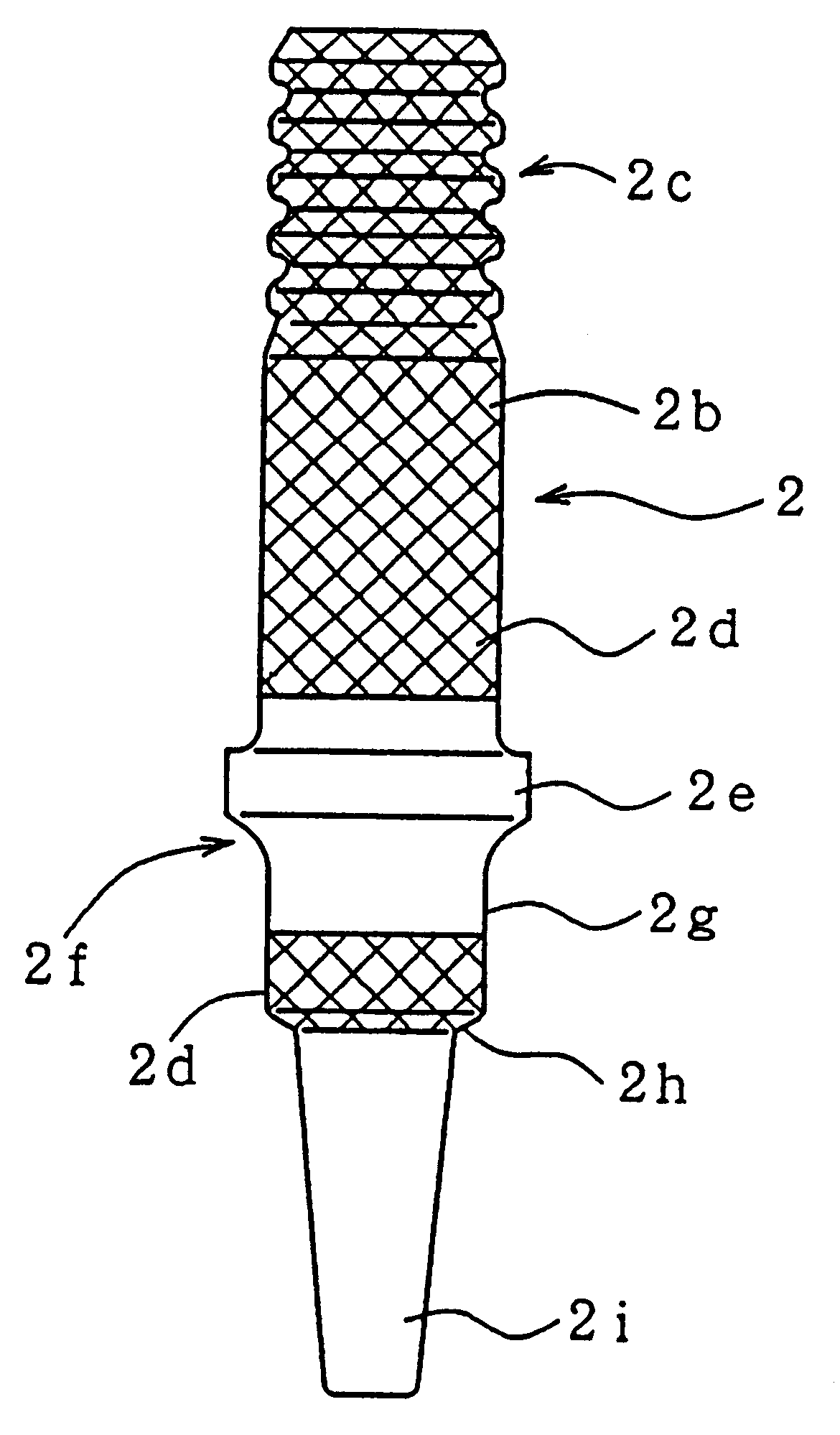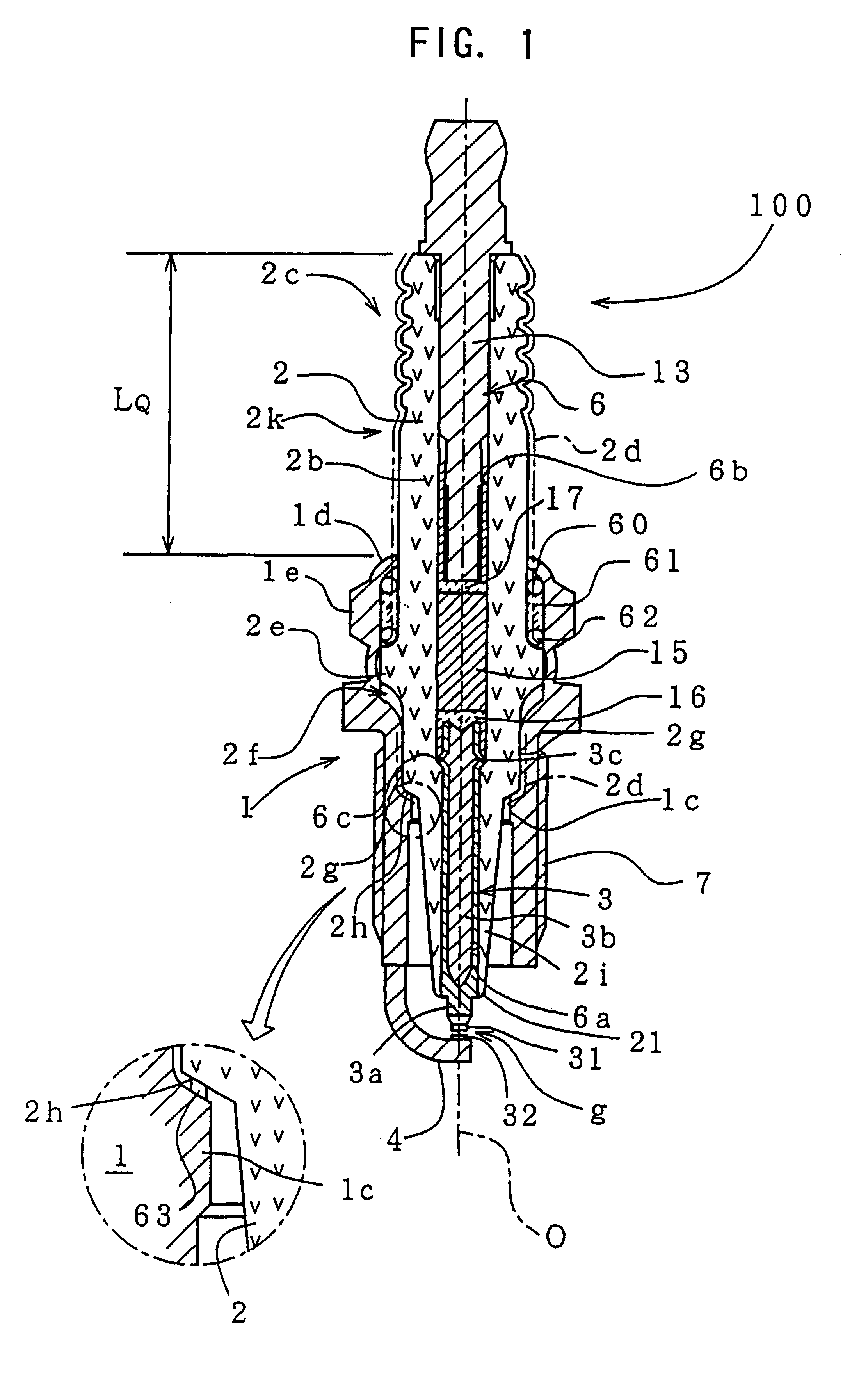However, if the spark plug is subjected to certain conditions simultaneously, such as high plug temperature, high
ambient humidity, and the like, application of
high voltage cannot successfully induce
spark discharge at the gap, and there may occur a so-called "flashover" phenomenon in which
spark discharge is induced between the terminal metal piece and the metallic shell such that the spark runs over the surface of the projecting portion of the insulator.
(1) Since the glaze has a coefficient of linear expansion lower than that of alumina-based insulating material which serves as a substrate, the obtained glaze layer is susceptible to cracks and the like.
(2) Although the glaze contains a considerable amount of PbO, the glost-firing temperature is still high; i.e., 1000.degree. C. or more. In the manufacture of spark plugs, glost firing is often performed concurrently with a glass sealing step so as to reduce the number of manufacturing steps. Therefore, high glost-firing temperature as described above disadvantageously permits accelerated oxidation of a terminal metal piece and a center electrode. A conceivable measure for further lowering the glost-firing temperature is to add
alkali metal oxide such as Na.sub.2 O to the glaze. However, if the amount of
alkali metal components is increased excessively, insulation performance is lowered, and the spark plug becomes susceptible to flashover.
(3) In recent years, concerns for
environmental protection have increased worldwide, and glaze containing Pb has been used less often. For example, the automobile industry, which uses a large number of spark plugs, is considering the complete abolition of spark plugs using glaze containing Pb, in view of the
environmental effect of discarded spark plugs.
That is, the present inventors conducted studies and found the following: In the case where an alkali metal component is added alone, as the amount thereof increases, the
conductivity of glaze drastically increases, leading to considerable impairment of insulation performance.
When the insulator to be coated with the glaze is formed of alumina-based insulating material, if the Si content is less than 18% by weight, the coefficient of linear expansion of the glaze becomes excessively high, so that the glaze layer becomes more susceptible to defects such as cracks.
By contrast, if the Si content is in excess of 35% by weight, the coefficient of linear expansion of the glaze becomes too low, so that the glaze layer becomes more susceptible to defects such as
crazing.
If the B content is less than 25% by weight, the
softening point of the glaze increases, which can lead to failure to attain glost firing at the prescribed desired temperature (800.degree. to 950.degree. C. as described above).
By contrast, when the B content is higher than 40% by weight, phase separation tends to occur in the
resultant glaze layer, which may result in
devitrification, deteriorated insulation performance, or incompatibility with the substrate in terms of the coefficient of linear expansion.
If the Zn content is less than 10% by weight, the
softening point of the glaze increases, which can lead to failure to attain glost firing at the prescribed desired temperature.
By contrast, if the Zn content is in excess of 25% by weight, the coefficient of linear expansion of the glaze becomes excessively high, so that the glaze layer becomes more susceptible to defects such as cracks.
If the Ba content is less than 7% by weight, the insulation performance of the glaze is lowered, which can lead to impaired flashover prevention.
By contrast, if the Ba content is in excess of 20% by weight, the
softening point of the glaze increases, which can lead to failure to attain glost firing at the prescribed desired temperature.
In this case, Na is calculated as reduced to Na.sub.2 O, K is calculated as reduced to K.sub.2 O, and Li is calculated as reduced to Li.sub.2 O. If the amount of at least one component is less than 3% by weight, the
softening point of the glaze increases, which can lead to failure to attain glost firing at the prescribed desired temperature.
Also, if the amount of at least one component is in excess of 9% by weight, the coefficient of linear expansion of the glaze excessively is increased, so that the glaze layer becomes susceptible to defects such as cracks.
If the total amount of the co-additional alkali metal components is less than 6% by weight, the
softening point of the glaze increases, which can lead to failure to attain glost firing at the prescribed desired temperature.
By contrast, if the total amount is in excess of 14% by weight, the insulation performance of the glaze is lowered, which can lead to impaired flashover prevention.
As a result, insulation performance of the glaze is lowered, which can lead to impaired flashover prevention.
When the total amount is less than 95% by weight, the softening point of the glaze increases, which can lead to failure to attain glost firing at the prescribed desired temperature.
As a result, the insulation performance of the glaze can be lowered, resulting in impaired flashover prevention.
If the
viscosity of the
slurry is drastically increased (for example, over 1000 mPa.multidot.s), uniform glaze-
powder-coated
layers become difficult to obtain, and bubbles and the like are more likely to be suspended in the
layers.
Also, addition of the alkali metal components in an amount over the range provides adverse affects in terms of securing the insulation performance of the glaze.
If the total amount of Ti and Zr is less than 2% by weight as reduced to the respective oxides, the effect of suppressing increase in the softening point of the glaze becomes insufficient, which can lead to a failure to attain glost firing at the desired temperature.
By contrast, if the total amount is in excess of 10% by weight, the glost-fired glaze layer disadvantageously becomes susceptible to
devitrification.
However, since each of the oxides of Ti and Zr is substantially a high-melting-point
oxide, if the total amount of the oxides is in excess of 10% by weight, the softening point of the glaze is adversely increased, which can lead to a failure to attain glost firing at the desired temperature.
When Ti is added in an excessive amount, the coefficient of linear expansion of the glaze layer is excessively low.
In this case, if the insulator to be coated with the glaze is formed of, for example, alumina-based insulating material, the difference between the coefficient of linear expansion of the insulator and that of the glaze can induce defects such as
crazing in the glaze layer.
As a result, the
viscosity of the molten glaze is increased in some cases, resulting in impaired appearance of the glaze layer.
As a result, the coefficient of linear expansion of the glaze layer becomes excessively low, so that the glaze layer becomes susceptible to
crazing and the like.
When the insulator to be coated with the glaze is formed of alumina-based insulating material, if the Si content is less than 20% by weight, the coefficient of linear expansion of the glaze becomes excessively high, so that the glaze layer becomes susceptible to defects such as cracks.
By contrast, when the Si content is higher than 40% by weight, the coefficient of linear expansion of the glaze becomes adversely low, so that the glaze layer becomes susceptible to defects such as crazing.
Further, there can result adverse effects involving problems as follows: the obtained glaze layer becomes more susceptible to
phase splitting, resulting in
devitrification; the insulation performance of the glaze layer is lowered; and a large difference is provided between the coefficient of linear expansion of the glaze layer and that of the material to be coated with the glaze.
If the Zn content is less than 15% by weight, the softening point of the glaze is increased excessively, which can lead to a failure to attain glost firing at the desired temperature.
By contrast, if the Zn content is higher than 25% by weight, the coefficient of linear expansion of the glaze becomes excessively high, so that the glaze layer becomes more susceptible to defects such as cracks.
If the Ba content is less than 10% by weight, the insulation performance of the glaze is lowered, which can lead to impaired flashover prevention.
By contrast, if the Ba content is higher than 23% by weight, the softening point of the glaze increases, which can lead to failure to attain glost firing at the prescribed desired temperature.
However, in many cases, the forms of the oxides cannot be identified; for example, because the components form amorphous glass phases.
C. If the coefficient of linear expansion falls below the
lower limit, the spark plug becomes susceptible to defects such as crazi
ng. By contrast, if the coefficient of linear expansion is above the upper limit, the spark plug becomes susceptible to defects such as cra
As a result,defective products
stemming from oxidation of the center electrode and the terminal metal piece are seldom produced, resulting in increased product yield of the spark plug.
In such a case, if the sintered conductive material portion contains a
resistor, performance characteristics such as service life under load can be impaired.
 Login to View More
Login to View More 


